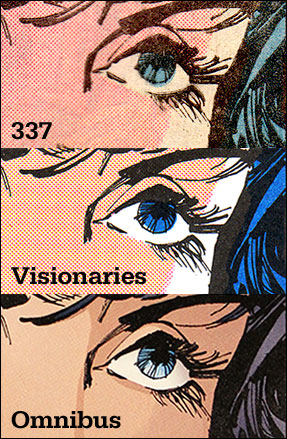Thor Omnibus: Walter Simonson
Created by: Walt Simonson, Sal Buscema, and Christine Scheele
Published by: PUBLISHER
ISBN: 0785146334 Amazon
Pages: 1192



As related in my review of Langridge and Samnee's wonderful Thor: The Mighty Avenger, despite years of enjoyment of Marvel's superhero-verse, I held a marked wariness of the company's Norse pantheon. Thor and Odin and Loki and all the Asgardian menagerie seemed goofy and stilted, an artifact of an era of publishing when I imagined readers were happy to read corny BIF-BAM-POW comics. The Asgardians were garishly colourful and bizarrely spoke in a kind of false Elizabethan English. And worse: their adventures, from what I gathered, were far divorced from the mythological tales I had learned as a youth.
It was Walt Simonson who turned Thor into a viable character for me.
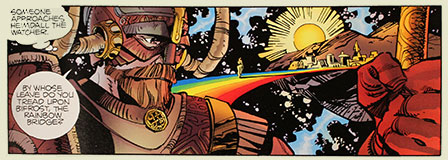
In the mid-'80s, I happened across Simonson's Thor via some crossovers with Simonson's wife's own series, Power Pack, and Claremont's New Mutants. I picked up the relevant issues of The Mighty Thor in order to get the full story, and while those issues weren't necessarily enough to instantly win me over, they gave me a foothold into Simonson's vision of Thor.11Sadly, because these crossover issues were interruptions in Simonson's story (one, for instance, involved Secret Wars II's the Beyonder), they provided very little insight into the grand tapestry Simonson intended to convey. Five years later, in rereading Power Pack to feed a nostalgia for my juniour high days, I pulled out the one or two issues of Thor I owned and reread them as well.
Though my portrait of Simonson's hero was drastically incomplete, I was intrigued. I then went ahead and picked up the rest of the series over several months (and visits to several comic shops). They were odd and exciting. I had a basic understanding of Thor's identity as Donald Blake and the fact that he would be returned to frail human form if he was separated from his hammer for too long. Simonson re-crafts the god of thunder right from the beginning of his run and almost immediately does away with Donald Blake, allowing Thor to be Thor for the duration of nearly fifty issues22There *are* a couple of delicious and notable exceptions. Beyond this trick allowing Simonson to focus on Thor's godhood, it also gives new readers an easier time of negotiating the character and his place in Marvel's mythology—primarily by eliminating the whole human swath of his (former) supporting cast. I mention this primarily to assure those who are unfamiliar with the hero outside his appearance in recent films that this omnibus edition of his adventures is as fine a place to start as any—if one is interested in reading the source material.33Although, there is no Jane Foster save for a cameo appearance late in the volume. I'm not sure what happened to her, as I had always understood her to be a Big Deal to Thor. (Much like one might imagine Betty Brant was a big deal to Spider-Man had one only access to the Bakshi cartoons from 1967.) As Simonson's run on the book spans chapters 337 through 382, I imagine that some writer along the way grew tired of the Thor/Foster lego and shuffled her off to married life safe from the clutches of Mr. Hydes or Absorbing Mans. In any case, Thor's infatuation with the woman seems long past by the time chapter 337 rolls around.
So then, the Omnibus.
At 1192 pages, this collection is a behemoth of computer-coloured bombasticism. When it arrived in the mail, I showed it off around the office to people who had no interest in comics whatsoever. Universally, the reaction was of awe and interest. The production is really rather breath-taking to behold. Not only does the book weigh about eight pounds, but it's so very, very bright—the colours used are vibrant, and while markedly different from those originally used (more on this later), they stray far from the desaturated palettes that have governed so much comics production over the last decade. Simonson's Thor is an exciting, epic tale and Marvel's printing here never lets the reader forget that.
Simonson's writing is superb. The ideas that govern Marvel's Thor are from another era and not in-line with the sensibilities of contemporary audiences. Simonson defeats this problem perhaps effortlessly (at least it seems so) by giving all his characters overly dramatic monologues, which they happily trade back and forth as if in dialogue. Their language is ludicrously flowery and their verbal ticks would be clownish if it weren't for their identities as gods. Somehow all this over-writing works—the characters and their lives become fascinating and engaging, something worth the readers' time to pursue.
One of the glories of Simonson's run on the book is that the whole thing (nearly) reads as a single story. While that sort of thing happens much more often post-AD 2000, in the mid-'80s, such a long-running arc was pretty rare. The first chapter of this omnibus begins with a great and shadowy figure slamming down a tremendous flaming ingot (made from an exploded galaxy) onto an anvil. The sound that ingot produces as it makes first contact with the anvil is an ominous onomatopoeia44 Onomatopoeia figures prominently in Simonson's Thor. So much so that his sound effects even take on the value of characters in their own right. Years after having read the original production of this story, it was sometimes Simonson's visual use of sound that stayed with me. that echoes across the universe: "DOOM!" It's a famous image from the era and recurs throughout the work while this particular piece of Simonson's saga works itself out. From there, story after story spins out, each the natural result of what came before. With few exceptions (and they seem to be publisher-mandated annoyances), nothing within the work stands alone.

Simonson also shows a wonderful knack for story beats. His narratives skip all over the place, with a page devoted to one character followed by two devoted to another followed by a half-page devoted to a third before returning to the first and then introducing a fourth. I'd say it was staggering to consider how he keeps so many narrative balls in the air while maintaining such a crisp story pace, but nowadays it seems like any number of worthwhile manga that hit American shores do the same. As well, Simonson seems happy to deliver several kick-ass moments per chapter—from charges against unbeatable foes to noble self-sacrifices to remembrances of those sacrifices to laugh-inducing come-uppances. Simonson the writer delivers.
But as much fun as Walt Simonson the writer is, it's probably Walt Simonson the artist who most viscerally turns Thor into a hero whose songs we want to learn. Simonson himself is on art chores for the first two-thirds of the book and when he bows out to keep strictly to the writing aspect, the book is poorer for the loss. It's not so much that Sal Buscema is a poor artist—it's more just that he's not Walt Simonson. (Simonson returns for the the big climax in the third-to-last chapter, and if that battle had been drawn by Buscema instead of Simonson, we'd be missing one of the greatest single chapters in comics history.) Simonson's art is rough and tumble, full of a kind of visual braggadocio. He makes these gods look as if they might actually be warriors. His design sense reveals a kind of dynamism that was largely missing from the era in which he worked (and isn't really apparent today either).
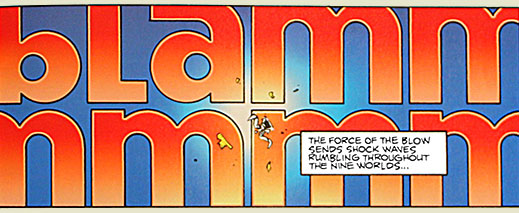
That I can unreservedly recommend this massive collection does not mean that there aren't issues with the work. After Buscema takes over on art, it seems like some of Simonson's writing spark wanes as well and I've always felt it difficult to be as invested in some of the latter stories. Another issue is due to a couple interruptive crossovers. In the aforementioned Power Pack crossover, the kids from Power Pack suddenly appear and are suddenly gone, and today's readers will probably have no idea who they are or what place they have in Thor's world. Even worse though, the primary McGuffin from Marvel's Secret Wars miniseries shows up having resurrected one of Thor's foes who had been killed earlier in the volume (the resurrection happens in another series and is not reproduced here). Later in the series, Thor gets shoehorned into participating in the X-Men event "The Mutant Massacre." And in another instance, occupying three bare panels, a costumed supervillain is unceremoniously murdered by a homeless person; it's part of the Scourge storyline running through Captain America's book at the time, but doesn't make any sense to readers without that kind of knowledge. These episodes are a shock to the system and a great argument against crossovers in the midst of ongoing stories. While the pagecount is already high, it would've been nice to have had some sort of explanation of these things—if this book is meant to be a kind of stand-alone omnibus.
The last diminishment to the book is a bit awkward: the re-colouring.
It's hard to be too upset about the recolouring job by Steve Oliff and his company Olyoptics. If I hadn't seen the original work by Christine Scheele, I wouldn't have thought anything of it. Oliff is a good colourist and has done a fantastic job on other projects (notably, his work on Marvel Epic's edition Katsuhiro Otomo's Akira is just beautiful). I'm sympathetic with the problem facing Marvel in reproducing older works like these. They almost demand recolouring. Because of primitive, cheap printing methods and the poor-quality paper used before computer-colouring, straight reprints fair poorly on the higher-quality paper of today. Here's a comparison (click to see it enlarged and with better detail):
The first panel is a scan from the original issue of Thor #337. You can see that the colouring is made from little dots, but because the paper is low-quality the dots tend to bleed, creating a more uniform colour-effect. It was fine for the time, but when we update the print via the second panel to higher-quality paper (as Marvel did for the first volume of their Thor Visionaries series) the dots don't bleed and remain very distinguishable. The effect is jarring. Marvel addressed this problem in later volumes of their Visionaries series by having someone re-colour the book in a way that perfectly mimicked the original colours but did so at a higher resolution. Still, the style of colouring in those original Thor books, even if the resolution is upped, is still a relic from a former era, so Marvel commissioned Steve Oliff to bring the book into a contemporary style (the third panel)—perhaps even one similar to what the original colourist might have used had the tech been available to her.
As I said, there's nothing wrong with Oliff's colours per se. It's just that they lack some of the marvelous invention of Christine Scheele's original work. Trapped by the severe limitations of the technology and budget Marvel was working with at the time, Scheele produced some incredible work. Here are two examples so you can compare Scheele's methods with Oliff's (click to enlarge either).
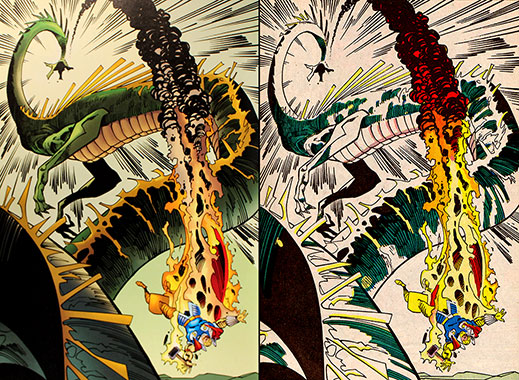 Oliff's art is on the left and Scheele's is on the right.
Oliff's art is on the left and Scheele's is on the right.
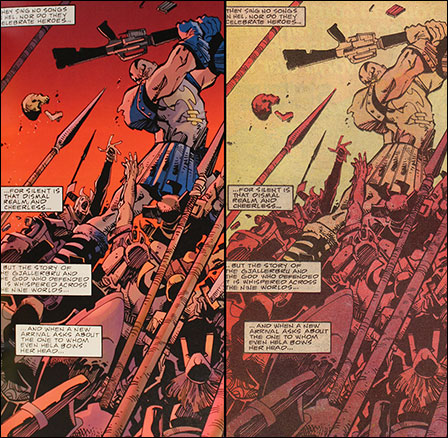 Oliff's art is on the left and Scheele's is on the right.
Oliff's art is on the left and Scheele's is on the right.
Scheele's colouring on the Midgard Serpent is almost minimalistic, allowing the whitespace of the page to do so much of the work for her. Oliff's is filled with colour but is somehow less grand—though without seeing the comparison, it'd be impossible to say Oliff's was not good. In Scheele's work on the scene with the Executioner, she employs only flat yellows and oranges. The page is washed in a duochromatic kind of violence. Oliff's use of gradients and more colours (returning blue to the Executioner's attire) robs the page of its original sense.
Ultimately, I'm not sure what the solution here is. While I found Oliff's colours usually refreshing, I probably would have preferred a bit more fidelity to Scheele's work—after all, that was a big part of what was so incredible about the original experience.
Still, small problems aside, this Omnibus should satisfy old fans and newcomers alike.
Good Ok Bad features reviews of comics, graphic novels, manga, et cetera using a rare and auspicious three-star rating system. Point systems are notoriously fiddly, so here it's been pared down to three simple possibilities:
3 Stars = Good
2 Stars = Ok
1 Star = Bad
I am Seth T. Hahne and these are my reviews.
Browse Reviews By
Other Features
- Best Books of the Year:
- Top 50 of 2024
- Top 50 of 2023
- Top 100 of 2020-22
- Top 75 of 2019
- Top 50 of 2018
- Top 75 of 2017
- Top 75 of 2016
- Top 75 of 2015
- Top 75 of 2014
- Top 35 of 2013
- Top 25 of 2012
- Top 10 of 2011
- Popular Sections:
- All-Time Top 500
- All the Boardgames I've Played
- All the Anime Series I've Seen
- All the Animated Films I've Seen
- Top 75 by Female Creators
- Kids Recommendations
- What I Read: A Reading Log
- Other Features:
- Bookclub Study Guides

